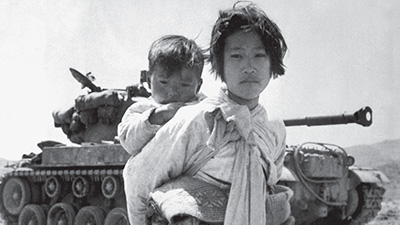Cold War and Decolonization
Teacher Resources
Driving Question: How did people and governments try to reshape the global order after the Second World War?
World War II may have ended, but global struggles over power and freedom continued. In this lesson you’ll step into a world divided by ideology and energized by revolution.
Learning Objectives:
- Use evidence to evaluate how the Cold War and decolonization are intertwined in the history of this period.
- Evaluate what changed and what stayed the same from the Second World War to the Cold War.
Vocab Terms:
- apartheid
- decolonization
- empire
- ideological
- protest
- superpower
- union
Opener: Cold War and Decolonization
To teach this lesson step, refer to page 2 of the Lesson 8.1 Teaching Guide.
Review the OER Project Teaching Sensitive Topics in Social Studies Guide as you work through sensitive subject matter with your students.
As you get ready to learn about the Cold War, consider what you think you know and what you know you don’t know.
Looking Ahead
To teach this lesson step, refer to page 3 of the Lesson 8.1 Teaching Guide.
For reading strategies, take a look at the OER Project Reading Overview.
The end of World War II left the world at a crossroads. Start exploring how independence movements and global rivalries emerged together, reshaping the balance of power across continents.
New Global Conflicts
To teach this lesson step, refer to page 4 of the Lesson 8.1 Teaching Guide.
Looking for some visual reminders of the frames for your students? These Frames Posters are great to post in your classroom!
After the Second World War, global empires crumbled and new tensions rose. Learn how independence movements, superpower rivalries, and shifting alliances created a new and often unstable global landscape.
-
Guiding Questions
-
Before you read
Preview the questions below, and then skim the article. Be sure to look at the section headings and any images.
While you read
Look for answers to these questions:
- How did the Second World War shift the focus of the global story you’ve learned so far?
- Why were some conflicts during this period described in different ways (Cold War struggles vs. decolonization) depending on one’s perspective?
- How was the Cold War an ideological struggle?
- What lasting changes came from decolonization and independence movements?
After you read
Respond to this question: Which do you think had a greater impact on the modern world — Cold War struggles or decolonization movements? Use evidence to support your answer.
-
Guiding Questions
-
Before you watch
Preview the questions below, and then review the transcript.
While you watch
Look for answers to these questions:
- Why did the United States and Soviet Union become rivals after the Second World War?
- How was decolonization connected to the aftermath of the Second World War?
- How were the Cold War and decolonization linked?
- How does US military spending show the Cold War’s global impact?
- What does the collapse of Soviet military spending in 1989 reveal about the Cold War’s end?
After you watch
Respond to this question: After two devastating world wars and two failed attempts at lasting peace, why do you think achieving global peace has been so difficult?
Key Ideas
Cold War Frames
To teach this lesson step, refer to page 5 of the Lesson 8.1 Teaching Guide.
Closers are a great way to assess student learning and progress. Learn more in the OER Project Assessment Guide.
The Cold War and decolonization were massive, complex conflicts In this step, you’ll practice using the frames of communities, networks, and production and distribution to make sense of how they unfolded and connected to each other.
-
Guiding Questions
-
Before you watch
Preview the questions below, and then review the transcript.
While you watch
Look for answers to these questions:
- What systems of production and distribution did the United States and Soviet Union promote?
- How does the communities frame help us understand decolonization?
- How did the Cold War and decolonization create new networks of leaders, rebels, and states?
After you watch
Respond to the following question: How does looking through the three frames help you understand the ways that the Cold War and decolonization were connected?
Key Ideas
Closer: Cold War and Decolonization
To teach this lesson step, refer to page 5 of the Lesson 8.1 Teaching Guide.
You’ve reached the end of this lesson, comrade! Use the propaganda in this activity to review what you’ve learned.
Poster Preview
Peer Review
To teach this lesson step, refer to page 5 of the Lesson 8.1 Teaching Guide.
Being able to provide clear and supportive writing feedback to a classmate isn’t just helpful to them—it will also help you develop your own understanding of strong writing.

















